Personal journeys in Eastern Japan

From being part of a tour group for my first ever trip in 2007, to travelling on my own both for work and play, I have taken a long time to cover the whole of Japan, with the last prefecture, Nagasaki cleared back in February 2023.
However, to write about all 47 prefectures will probably be an exhaustive read, and hence, in an attempt to narrow down the scope, I will focus on prefectures that can be accessed by the various passes available for purchase via JR-EAST Train Reservation.
Hokkaido (北海道)
Outside of Tokyo, I have personally visited this prefecture the most and have made many friends there. This included a 1-month stint on a summer programme at Hokkaido University, which included a live-in experience working on a pension during the summer, and then revisiting subsequently years after.

A day will come where I will finally get to see Hokkaido University’s gingko trees in autumn. (Image credit: photoAC)
Giving too much detail would make this article overly long, so here’s a non-exhaustive summary of places that I have visited over the years:
Sapporo: TV Tower, Odori Park, Sapporo Beer Museum, Mt Moiwa, Moerenuma Park, Shiroi Koibito Park / Factory, Sapporo Factory, Clock Tower
Otaru: Canal Area, Sakamachi Street (Music Box Museum, Bank of Japan Museum)
Niseko: Country Inn Milky House, RADIO NISEKO
Furano / Biei: Shikisai-no-oka, Takushinkan, Blue Pond, Farm Tomita
Lake Toya: Locations featured in the TV anime “Celestial Method”, including the main lakeside promenade with its various art installations, Morito Kinosato Center
Noboribetsu: Jigokudani and staying at an onsen.
Hakodate: Ohnuma Park side trip, Mt Hakodate (1 of 3 Night Views of Japan), Lucky Pierrot (local burger chain only found in Hakodate), Fort Goryokaku, Morning Market, Motomachi District. Anime fans would also appreciate its link with Love Live! Sunshine!! where one of the school idol groups featured in the anime actually lives in Hakodate, and the city used to distribute a guide map featuring locations featured.
For someone living in a perennially warm country with little variation in seasons, one enjoyment of mine is visiting the same location during different seasons and getting a very different view.
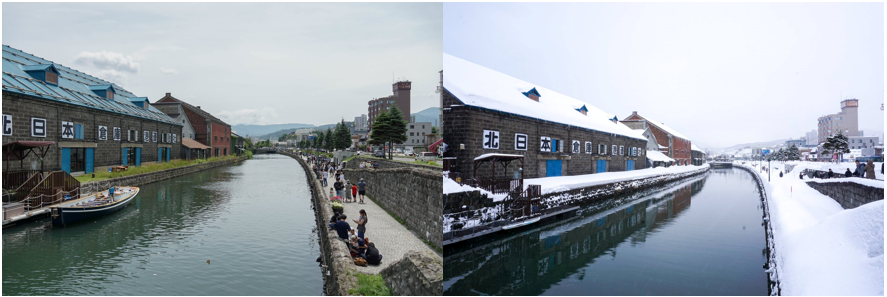
Otaru Canal during the summer (left) and winter (right). (Image credit: JR East/Johnny Goh)
Future plans: Go further north and east, to cities such as Kushiro, Obihiro as well as the northernmost point of Wakkanai.
In terms of getting around, it was a mix of self-driving as well as using rail to get around. For Furano-Biei, I used the Furano-Biei Free Pass (a pass that’s no longer available, but the current day version that most resembles it is Sapporo-Furano Area Pass) for a day trip. Other parts of Hokkaido involved using the Japan Rail Pass (Nationwide) and the JR East-South Hokkaido Rail Pass.
Prior to the opening of the Hokkaido Shinkansen section between Shin-Aomori and Shin-Hakodate-Hokuto, there used to be a sleeper train, called Hamanasu that operated between Sapporo and Aomori, and I was lucky enough to ride that before it was discontinued with the opening of the Shinkansen. Please note that the modern day “Hamanasu” name is now used as the name of the train formations used by various Limited Express trains in Hokkaido currently.
Honestly, given its size, Hokkaido could be an article by itself.
Aomori (青森)
Famous for both its apples as well as the “sakura moat” at Hirosaki Castle (弘前城 Hirosaki-jō), I first visited Aomori in spring in 2013. Being able to see for yourself the actual moat of Hirosaki Castle covered in sakura petals, made me realise that the promotional materials weren’t lying about the abundance of the flowers!

You can barely see the moat under the sakura petal blanket. (Image credit: JR East/Johnny Goh)
Hirosaki can be accessed via local trains on the Ou Line from Aomori, and also via the Limited Express Tsugaru.
Most recently in the summer of 2023, I also visited Lake Towada by taking a rental car from Hachinohe, via the road that follows the Oirase Stream, and stopping wherever I could for photos.

About to head out on a sightseeing boat at Lake Towada. (Image credit: JR East/Johnny Goh)
My only regret was that I spent so much time stopping along the Oirase Keiryu (奥入瀬渓流 Oirase Keiryū) for photos, that I did not leave enough time to explore Hachinohe itself.
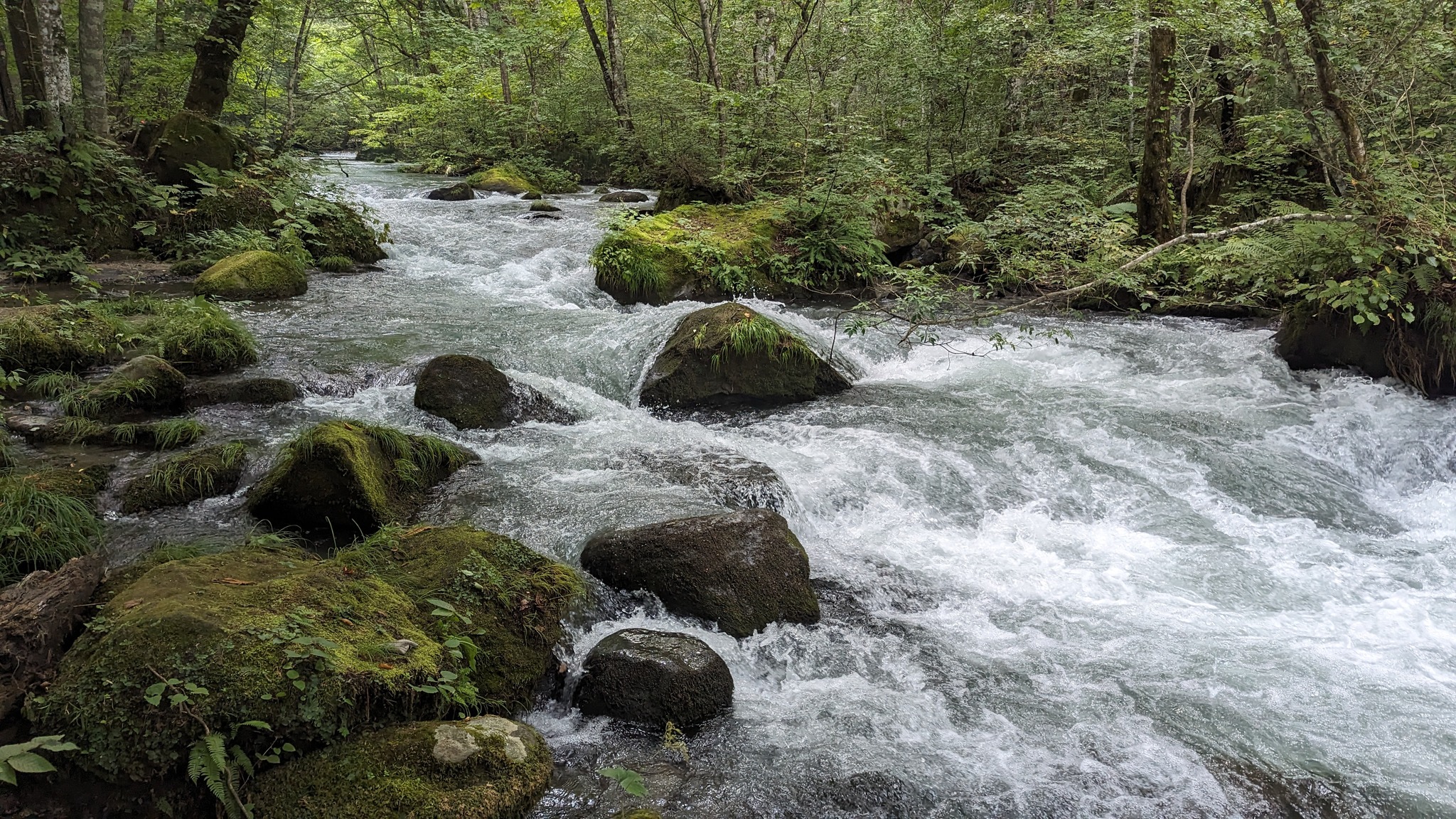
Stopping to take in Oirase Keiryu imagery. (Image credit: JR East/Johnny Goh)
Hachinohe is accessible via the Tohoku Shinkansen, via the Hayabusa if travelling up from Tokyo, but do note not all Hayabusa services stop at Hachinohe.
Future plans: Riding the Resort Shirakami along the Gono Line. In the past, I have placed an emphasis on covering a wide distance to make full use of the Japan Rail Pass (Nationwide) as much as possible, but now that the main bucket list is done, it’s time to slow down and focus on individual regions and the corresponding rail passes.
Iwate (岩手)
Continuing with the “one prefecture a day” theme I had going for the 2013 trip, Morioka (盛岡市 Morioka-shi) was the base for visiting places around Iwate. While in Iwate, I did the UNESCO World Heritage site tour of Hiraizumi, for which the various Temples, Gardens and Archaeological Sites Representing the Buddhist Pure Land were added in 2011, via the local loop bus service centred around Hiraizumi station on the JR Tohoku Main Line.

Chusonji, one of the many stops the local loop bus stops at. (Image credit: photoAC)
Hiraizumi, (if visiting via Morioka), can be accessed through a transfer from the Tohoku Shinkansen at Kitakami and then on to the JR Tohoku Main Line. If coming up from Tokyo, then a transfer at Ichinoseki is required.
Also, Morioka is also the station where the Hayabusa decouples with the Komachi, with the Komachi heading on to Akita. In the past before the opening of the Hokkaido Shinkansen, it was the Hayate / Komachi pairing, and you can observe the coupling / decoupling of trains on the platform.
Coming really soon, we will have an article that is based on the perspective of a Shinkansen driver, so please keep a look out for this.
Future plans: Break personal record for wanko soba, a local way of serving soba in bite-sized servings and a server refills your bowl with a new serving once you finish one until you give up. Personal record stands at exactly 100 bowls.
Aside from historical buildings, I would also like to visit natural formations, which necessitates a visit again to visit Geibikei Gorge.
Miyagi (宮城)
Sendai (仙台) - It is the biggest city in the Tohoku region, and is also one of the cities I have visited the most (4 times). It is pretty much routine for me to stop by at the Gyutan-dōri in the station building for a Gyutan set that comes with rice mixed with barley, grated yam and oxtail soup at my favourite shop.

Typical gyutan set meal that comes with pickled vegetables, barley rice and oxtail soup. (Image credit: photoAC)
It was also the place where my family made full use of the Japan Rail Pass (Nationwide) to go sakura hunting. After missing the peak in Takasaki, Gunma, we decided on the fly to head up to Sendai, and found our goal at Tsutsujigaoka Park. You can also do the same with the JR EAST PASS (Tohoku area), should you find yourself needing to make impromptu day-trip adjustments.
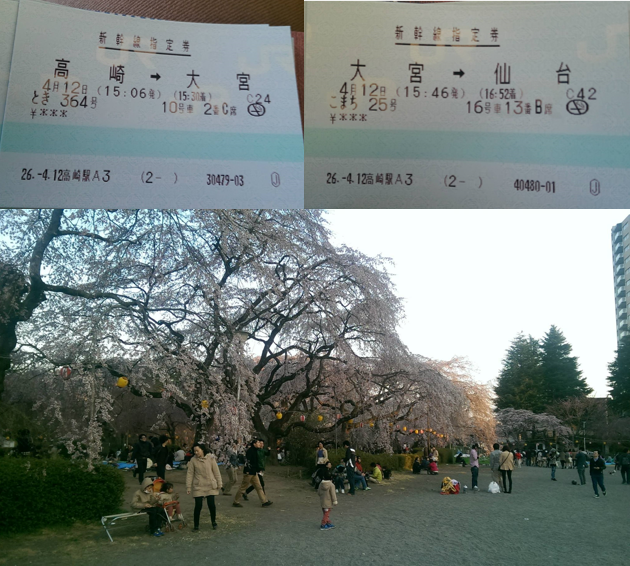
Making my way from Omiya to Sendai via Takasaki to find sakura at Tsutsujigaoka Park. (Image credit: JR East/Johnny Goh)
From Tokyo, all Hayabusa and Yamabiko Shinkansen services stop at Sendai, and guess what: the train also reaches a top speed of 320km/h, the fastest among all shinkansen lines in Japan!
Matsushima (松島) - The first of Japan's Three Great Views of Japan (日本三景 Nihon Sankei) that I visited back in 2013, about a year before a ban on feeding the seagulls was instituted. The attractions of Matsushima are centred around Matsushimakaigan Station (松島海岸駅) on the JR Senseki Line (仙石線 Senseki-sen), with Matsushima Station nearby, being on the JR Tohoku Main Line and is a distance away.

Seagulls following sightseeing boats around the Matsushima Bay. (Image credit: JR East/Johnny Goh)
Akita (秋田)
Kakunodate (角館) - I visited this place just past the Sakura peak, also in 2013. As it was late April, it was nice spring time weather, I walked for 20 mins to get from Kakunodate Station (角館駅) to Kakunodate Samurai Residence Street (角館武家屋敷通り Kakunodate Bukeyashiki Dо̄ri) to see how the historic buildings blend in with the sakura trees.
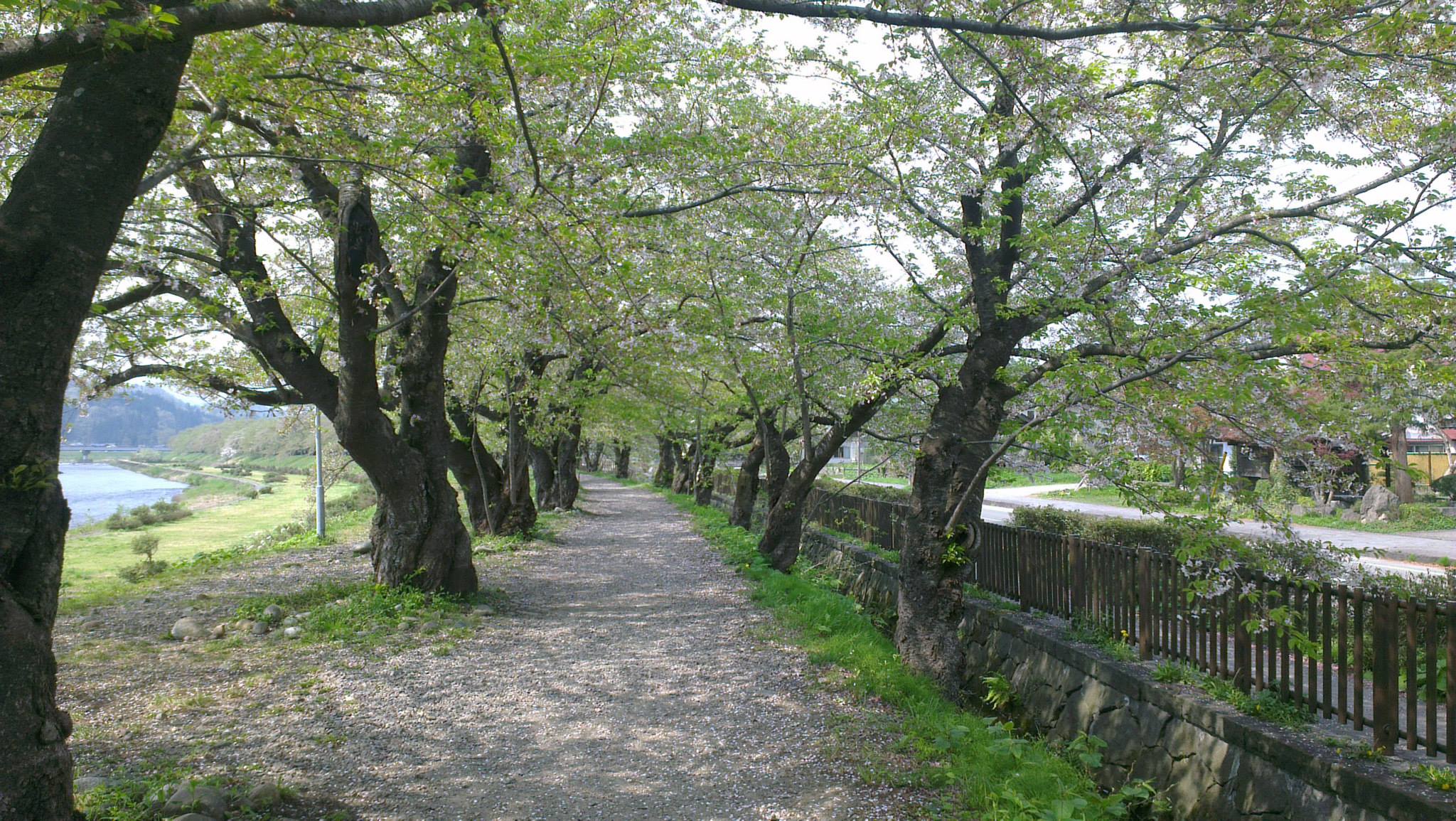
Past peak sakura trees along the Hinokinai River. (Image credit: JR East/Johnny Goh)
Nyuto Onsen (乳頭温泉) - One of my smaller goals each time I am on a private trip to include a stay at a hot spring inn (旅館 ryokan) in an area known for hot springs (温泉 onsen). So the jokes practically speak for itself when I came across Nyuto Onsen (乳頭温泉 Nyūtō Onsen), which literally translates to “nipple hot springs” and it’s milky spring waters. However, putting the jokes aside, I had a wonderful time at the location I stayed in, especially when it came to buffet offerings for dinner, with lots of local specialties like kiritanpo (きりたんぽ) (Akita speciality) and yamaimo soup served with watershield (Lake Tazawa specialty with watershield being in season during summer)

Yamaimo soup (left) and soup served with kiritanpo (right) at the ryokan I stayed in. (Image credit: JR East/Johnny Goh)
Lake Tazawa (田沢湖) - The deepest lake in all of Japan is relatively undeveloped apart from the eastern end where you could engage in watersports and board a sightseeing boat. Sights to visit around the lake, include the Goza no Ishi Shrine with a torii gate overlooking the lake.

Watersports facilities at Lake Tazawa. (Image credit: JR East/Johnny Goh)
Kakunodate, Lake Tazawa and Nyuto Onsen are all accessible via the Akita Shinkansen. The main sights of Kakunodate are a walk away from Kakunodate Station, whereas Lake Tazawa and Nyuto Onsen require a transfer to a local bus.
Future plans: To visit the Omagari Hanabi (大曲の花火 О̄magari no Hanabi) fireworks festival, one of the biggest in Japan, During the festival, there are normally temporary increases in Shinkansen services that help bring people to and from the city, as accommodation within the city is typically insufficient for the number of visitors.
Yamagata (山形)
The only prefecture in Tohoku which I have not stayed overnight yet, and I hope to change that in future.
As a day trip out from Sendai, I stopped at Yamadera (山寺) to climb the thousand or so steps up to Godaido Hall, overlooking the scenery. The view is a well-deserved reward after that climb.

View from Godaido Hall, Yamadera. (Image credit: JR East/Johnny Goh)
One of the main takeaways I had as I alighted was spotting a postal box near the top, which really struck me that a postal worker has to put in a lot of effort to make it all the way up to collect mail, providing that essential service to the residents.

Postal box near the top of Yamadera. (Image credit: JR East/Johnny Goh)
Yamadera is a local train right away from Sendai via the JR Senzan Line, and can also be accessed via the same line from Yamagata in the opposite direction. The various sights are within walking distance from Yamadera Station (山寺駅).
Future plans: To stay in Ginzan Onsen (銀山温泉), but normally reservations are hard to get unless you have planned out your holiday way out in advance.
Fukushima (福島)
Aizu-Wakamatsu (会津若松) - This city has a convenient loop bus centred around the JR Aizu-Wakamatsu Station (会津若松駅), which allowed me to visit in order, Tsuruga Castle (鶴ヶ城 Tsuruga-jō), a tour at the Suehiro sake brewery, one of the most famous sake producers in the Tohoku region, as well as Oyakuen, a traditional Japanese garden when you could stop and rest for a bit after a long day of rail travel and visiting local sites.

Tsuruga Castle in spring. (Image credit: photoAC)
Personally, I stopped by Aizu-Wakamatsu after visiting Niigata, hence my route took me via the JR Shin'etsu Line (信越線 Shin'etsu-sen) and the JR Ban-etsu West Line (磐越西線 Ban-etsu sai-sen) with a transfer at Niitsu, but Aizu-Wakamatsu is also accessible via the Tohoku Shinkansen, with a transfer at Kōriyama Station (郡山駅) onto the JR Ban-etsu West Line.
Future plans: To visit Ouchijuku, and Kitakata for the famous local ramen.
Ibaraki (茨城)
Mito (水戸) / Oarai (大洗) - I visited this location purely on the basis of trying to visit locations featured in the anime Girls und Panzer. There are also other snippets of anime tourism dotted across this article which is one of the ways I try to keep things interesting as I visit new cities, and also to visit locations that might not be as well-known.
Mito is a straight shot from Tokyo via the Joban line on the Hitachi and Tokiwa Limited Express services. Both services make a stop at Mito. After which there will be a transfer to a private railway line to get to Oarai.
Please refer to my Oarai article for some insights as well.
Tochigi (栃木)
Nikko (日光) - Aside from the World Heritage locations like the Toshougu, there’s plenty of things to do if you get out of central Nikko.
Due to my previous work, generally the lull period is during winter, where unfortunately, some places may be closed. I felt this the most when visiting Lake Chuzenji, where many shops and facilities were closed for the season. However my view of the Kegon Falls was somewhat better due to the less number of tourists around. Since I made use of Tobu Buses to get there, the experience of the winding hairpin turns of Irohazaka, a pair of roads with each road only accessible in one direction, really made you feel like you were in the car racing anime Initial D.

Kegon Falls almost frozen over in winter. (Image credit: JR East/Johnny Goh)
Personally I made use of the Tobu NIKKO PASS ALL AREA as it also included the bus services that radiate out from Tobu Nikko Station. However, JR EAST PASS and JR TOKYO Wide Pass users can make use of their passes to ride on the Nikko / SPACIA Nikko services direct from Shinjuku to Tobu Nikko Station. Visitors to Kinugawa Onsen can go on the Kinugawa / SPACIA Kinugawa services.
Another coincidence was that the operator of the hostel I stayed in near Nikko Station, once worked in Singapore so that was this immediate friendship that was struck when I checked in.
The owner told me about Ryūōkyō (龍王峡), which is a gorge on the upper stream of the Kinugawa River that also has wonderful views. It’s a good hidden side trip that visitors to Nikko don’t usually know about. Moral of story: Try to ask your local accommodation operator for recommendations!

Ryūōkyō on a wet, wintery day. (Image credit: JR East/Johnny Goh)
Gunma (群馬)
Takasaki (高崎) - In late April, another type of flower is in season in this region. The Moss phlox (Shibazakura) is viewable at the Misato Shibazakura Park (みさと芝桜公園), which is accessible by bus from Takasaki station (高崎駅). From Takasaki, even though that’s not the route I took, you can move on to one of the famous onsen towns that are present in the prefecture.
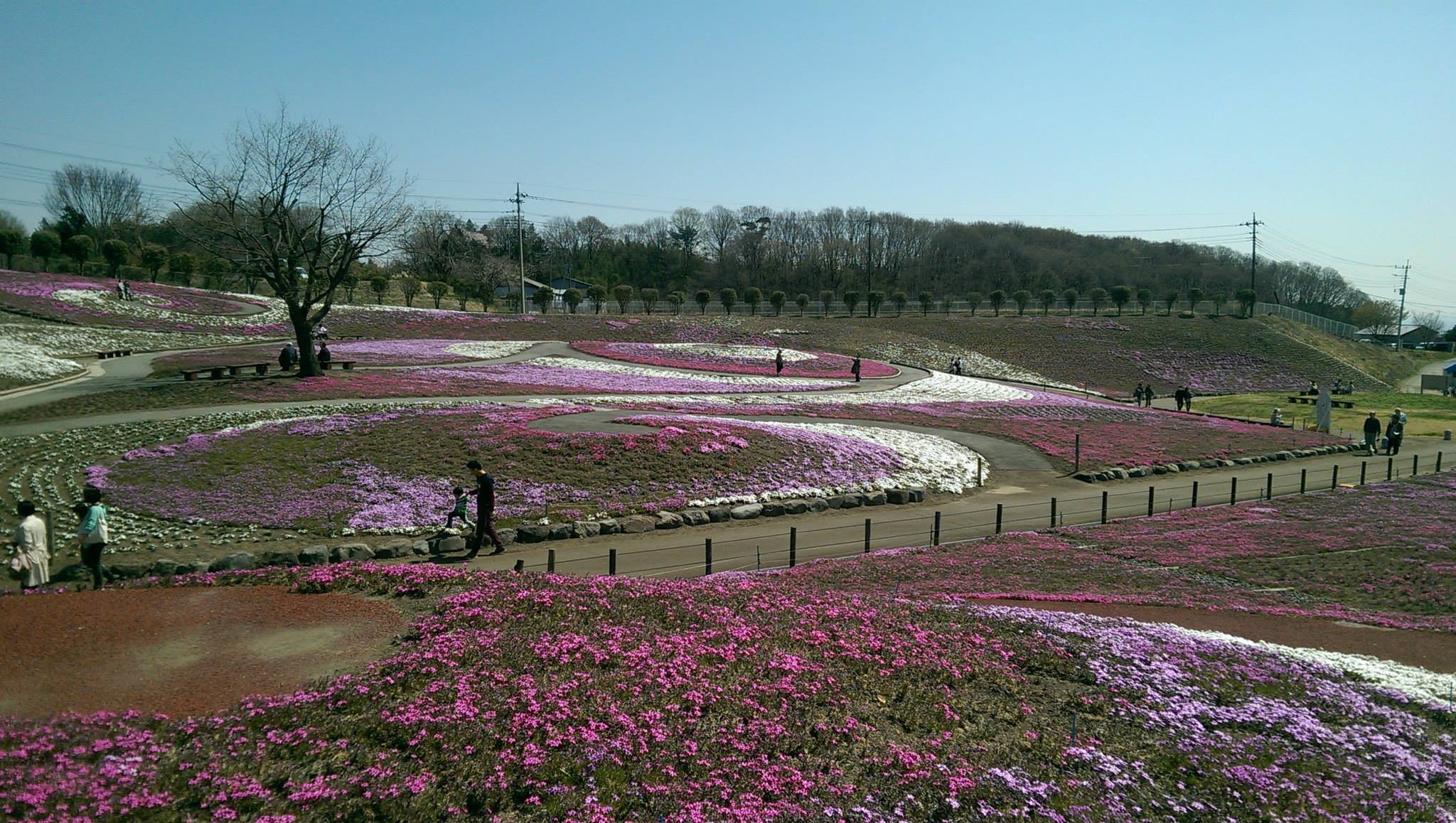
Arrived a few days before the peak to Misato Shibazakura Park. (Image credit: JR East/Johnny Goh)
Takasaki is also a big Shinkansen interchange station where trains on the Joetsu and Hokuriku Shinkansen will branch off and head for their respective destinations.
Kusatsu (草津) - With the self-imposed rule of including an onsen stay in any private trip, how could I miss one of the most famous onsen towns in Japan? Do note that the smell of sulphur emanating from the Yubatake in the centre of town is really strong so you might want to find a ryokan further away if you are sensitive to it.
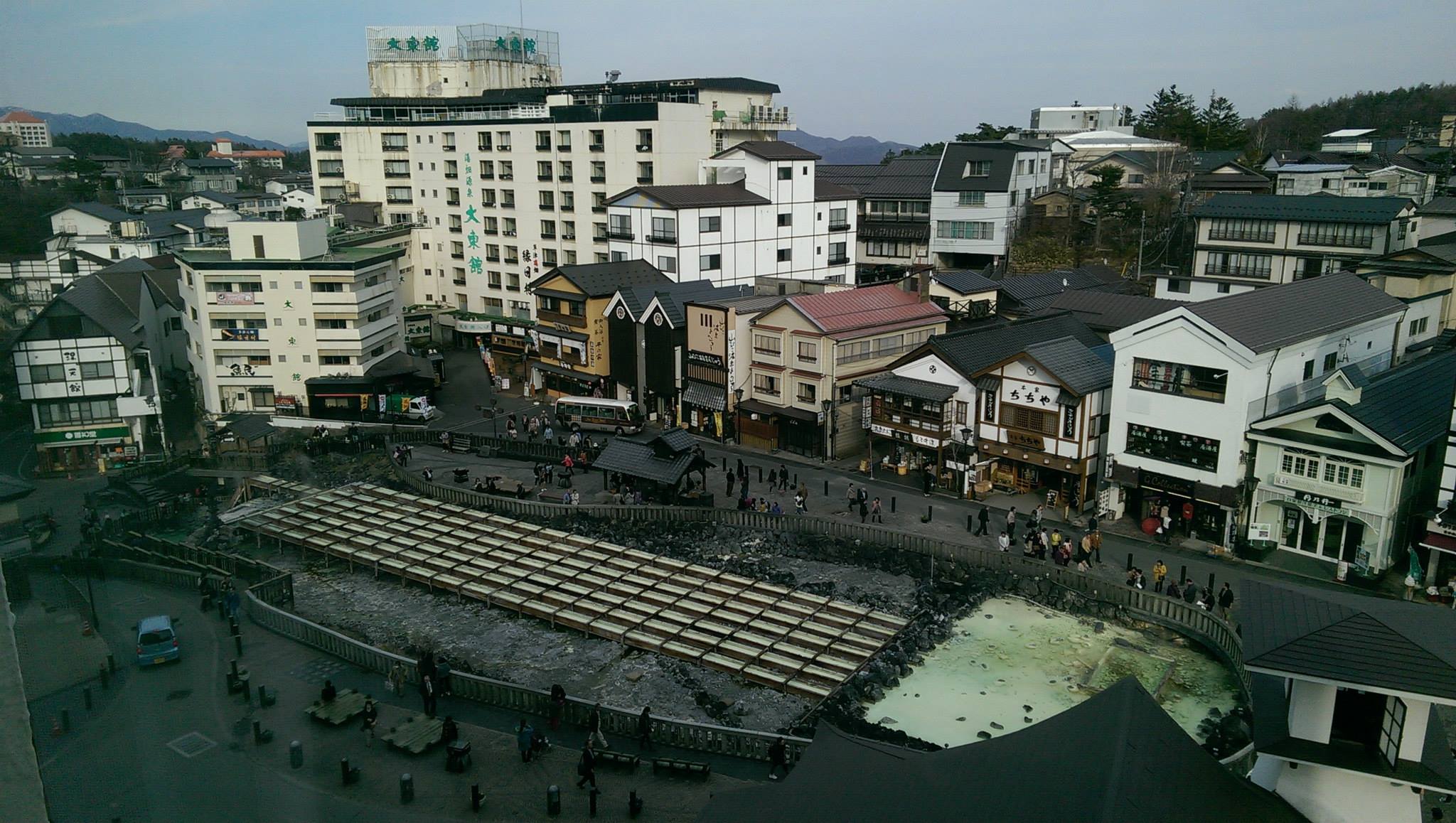
Great view of Yubatake from my room. (Image credit: JR East/Johnny Goh)
There is also the Sainokawara Park, which is home to a large open-air bath which you can partake in.

Pathway towards Sainokawara Park. (Image credit: JR East/Johnny Goh)
Kusatsu requires a bus transfer at Naganoharakusatsuguchi Station (長野原草津口駅), and the cost of the bus journey if you are a rail pass user, is only covered by the Japan Rail Pass (Nationwide), JR EAST PASS (Nagano, Niigata area) and the JR EAST PASS (Tohoku area).
Saitama (埼玉)
Saitama is basically otaku central for me. With the Saitama Super Arena right next to the Saitama Shintoshin station, lovers of anisong (theme songs made for anime opening and ending sequences) gather every year in August for one of the biggest music festivals of the year. Other big anime franchises that are closely related to music also hold big events at the same arena.
Saitama Shintoshin Station is very well connected to Tokyo, with services on various lines, like the Keihin-Tohoku Line and the Takasaki Line (Ueno-Tokyo Line). But if your JR EAST PASS is still active and the station is crowded when a concert ends, you could always head northwards to Omiya before heading back into Tokyo in style via the Shinkansen.
Chichibu (秩父) - A town that has absolutely embraced the fact that it was the setting for multiple anime, such as "Ano hana" (あの花) and "Her Blue Sky" (空の青さを知る人よ Sora no Aosa o Shiru Hito yo) due to the fact that the script / screenplay writer Okada Mari (岡田 麿里) grew up there, and is a nice day-trip candidate outside of Tokyo.
Chichibu is one of the cities that does not have a direct connection to any JR lines, with a transfer required at Kumagaya. However, via Seibu Railways, it is a non-stop trip from Seibu Ikebukuro Station to Seibu Chichibu Station.

Old Chichibu Bridge, featured prominently in several anime productions. (Image credit: JR East/Johnny Goh)
Kawagoe (川越) - While known more as “Little Edo”, I added a bit more spice into my trip, looking for locations featured in the anime “Tsuki ga Kirei”. It is interesting to try to replicate certain scenes, while also getting to know the history behind a certain landmark.
Kawagoe is quite well connected, with service by JR as well as other railway companies. Via JR, a transfer to the JR Kawagoe line at Omiya is required. From there, the local city can be navigated on foot or on loop bus services. Certain areas also provide bicycle rentals for a speedier way to get around.
Chiba (千葉)
Narita International Airport (成田国際空港) - Being one of the 2 main gateways into Tokyo, I have had the chance to stay in one of the hotels near the airport ahead of a morning flight out of Narita Airport.
Other than that, there are various ways to get to and from Narita Airport, including the N'EX TOKYO Round Trip Ticket, or if you happen to be using the JR EAST PASS or JR TOKYO Wide Pass, the ride on the Narita Express is also covered. The ride reliably takes approximately an hour from Tokyo Station (東京駅), so do factor that into your transport schedule so you don’t end up being late if you’re flying in/out of Narita. I personally have had to cancel some business meetings before due to unexpected circumstances.
Aside from that, Chiba is also an area that is ripe for events, with the presence of Makuhari Messe being opened for large anime expos, as well as concerts. I personally attended one before at the Marine Stadium, an open-air stadium which gave a perfect opportunity to set off fireworks as part of the special effects during a concert.

The bigger the stadium show, the longer the merchandise queue. (Image credit: JR East/Johnny Goh)
Come to think of it, that trip to Tokyo Disneyland was 16 years ago, so I don’t exactly retain many memories from then, but perhaps with the upcoming expansion to Fantasy Springs area in Tokyo DisneySea, it would be a chance to visit.
The Makuhari area, and the Disney-related attractions are all along the JR Keiyo Line. The station platform in Tokyo station is some ways away from the usual lines traversing central Tokyo like the Yamanote, so do buffer enough time for wayfinding if you are making an in-station transfer.
It is also really interesting to identify groups of people on the train based on the merchandise that they carry back to Tokyo. It does get crowded at the end of events so be prepared to experience shoulder-to-shoulder rides if you happen to be there, especially on weekends.
Future plans: Boso Peninsula to visit Kujukurihama. An interesting way to get around is the B.B.BASE that allows for a trip that combines cycling and rail travel.
Tokyo (東京)
To be honest, having been there for work annually as a result of an annual expo, as well as having there are too many places to list and where one should go really depends on personal interests.
You will get the usual recommendations like Akihabara and Ikebukuro for fans of anime culture, or a myriad of places for shopping to cater for all sorts of budgets, such as Ameyoko in Ueno, Shibuya, Omotesando, Shinjuku and more…
Getting around Tokyo is relatively simple, centred around the Yamanote Line (山手線). Journeys solely on JR trains are possible if you are trying to maximise the use of your rail passes, but there are also many alternatives to get around such as the Tokyo Metro / Toei Subway and other private rail lines radiating away from the Yamanote, such as the Yurikamome and Rinkai lines to get around Odaiba.
However, a good side trip is to actually take the Chūō Line (中央線) out of central Tokyo to Takao and hike up Mount Takao (高尾山 Takao-san). Even without regular exercise, it should be easy enough to reach the summit, after which there are trails to other summits for the more adventurous hikers.

Indication of the distance of the trail to reach the peak of Mt. Takao. (Image credit: JR East/Johnny Goh)
One unique place for rail lovers is the Hobby Center Kato Tokyo, where model trains and automation parts made by the company are on sale. There are also dioramas where you can see your favourite model trains including the Shinkansen in action. I was requested by a friend to find specific parts, but ended up having a great time myself.
Kanagawa (神奈川)
Being near Tokyo, Enoshima (江ノ島) is pretty much the first stop for most anime based in Tokyo when they are thinking of heading out for a holiday! There are also many such titles set within the location itself, with one of the most famous being Slam Dunk, with the railway crossing from the opening animation regularly visited by tourists trying to replicate the scene, me being one of them.
Perfectly doable as part of a day trip, I started off in Kamakura (鎌倉), visiting the Great Buddha before making use of the Enoshima Electric Railway aka Enoden, to get to Enoshima and then onto Fujisawa for the trip back to Tokyo.

Clear weather at Enoshima during a cold February. (Image credit: JR East/Johnny Goh)
Only the Enoden portion is on a private rail company, as Kamakura is served by JR via the Yokosuka Line and the Shonan-Shinjuku Line. Fujisawa is serviced by the Tokaido Line with some services running through onto the Shonan-Shinjuku Line.
Separately, Yokohama, where I usually only visit when taking in concerts at some of the venues in the area. Typically, while waiting around for the show to begin, I took the chance to visit places like Minato Mirai, Chinatown, GUNDAM Factory at Yamashita Pier (currently scheduled to end in March 2024), and the Red Brick Warehouse area.

View of Yokohama skyline from Yamashita Pier. (Image credit: JR East/Johnny Goh)
There is also a western pub in Yokohama that has become the de-facto post-event gathering spot for my friends after concert events.
To get to the various facilities via JR lines, it is more convenient to proceed to Sakuragicho Station (桜木町駅) on the Negishi Line (根岸線) instead of dropping off directly at Yokohama Station (横浜駅).
Niigata (新潟)
Aside from the main islands of Japan, I took the time to explore some of the smaller islands and you might just find gold. One of which is Sado Island (佐渡ヶ島 Sado-ga-jima) used to be renowned for producing gold and silver, and certain locations play into that, allowing you to experience panning for gold.
Getting to Niigata is the straightforward part, being the terminus station of the Jōetsu Shinkansen (上越新幹線), a trip from Tokyo on the fastest Toki service takes about 2 hours. There are 2 ways to get to Sado Island: the faster, more expensive jetfoil (1 hour) and the slower car ferry (2.5 hours). On the island, there are bus services to the sightseeing spots like the Sado Gold Mine, or even to experience rowing the tarai-bune, a tub-shaped fishing boat.

Moments before failing really hard at rowing a tarai-bune. (Image credit: JR East/Johnny Goh)
Niigata is famous for its production of rice as well as sake. With so many varieties from various sake brewers, it is sometimes hard to decide what to get. Back in Niigata City itself, Ponshukan (ぽんしゅ館) is a place where you can get to sample hundreds of varieties before deciding on what to get. This place truly encourages multiple visits, and even the most non-discerning person can detect the differences between brands of sake in terms of smell, taste and texture.
There are 3 Ponshukans in Niigata, besides the one at Niigata Station, the other locations are Echigo-Yuzawa Station and Nagaoka Station. All of them are highly accessible, being immediately next to the station.
Toyama (富山)
Another prefecture where I have yet to spend a night, and probably looking forward to planning a trip around when the next extension of the Hokuriku Shinkansen opens in March 2024.
When I went, in 2014, the Hokuriku Shinkansen had yet to open to Kanazawa, so back then it was a trip on the Thunderbird Limited Express between Kanazawa and Toyama. Now, with the Hokuriku Arch Pass, you can access Toyama much more easily. As a tourist, I really appreciate how the Shinkansen has helped to reduce journey times from place to place.
I did visit Tateyama Kurobe Alpine Route (館山黒部アルペンルート Tateyama Kurobe Arupen Rūto) on the behest of my parents, who first saw this place on a travel program on TV, and we did so on the first day the Route was open to tourists in 2014. Being from a country that never snows, it really is a stark contrast to having to be in winter wear in April, seeing a snow wall that’s 18 metres tall. It truly is something extraordinary to see with your own eyes.

Crowds at the famous Snow Wall along the Tateyama Kurobe Alpine Route. (Image credit: JR East/Johnny Goh)
Personally, as an engineer by education, being able to see the history behind the construction of the Kurobe Dam was also really interesting, with the added touch of the cafe serving curry rice with the rice shaped as a dam holding back the curry sauce. We did a day trip from the Toyama side (Tateyama) and ended on the Nagano end (Shinano-Omachi).

Frozen reservoir behind Kurobe Dam. (Image credit: JR East/Johnny Goh)
Ishikawa (石川)
Prior to doing the Tateyama Kurobe Alpine Route as part of the same trip with my parents in Kanazawa, the focus was mainly on the main attractions that people are familiar with, such as Omicho Market (近江町市場 Ōmichō Ichiba), Kenrokuen (兼六園), Kanazawa Castle (金沢城 Kanazawa-jō) and the Higashi Chaya District (東茶屋街 Higashi Chaya-gai). These locations are all covered by the loop bus that starts and ends at Kanazawa Station, so it is really convenient to do everything in a single day.

The iconic wooden torii gate at the entrance of Kanazawa Station. (Image credit: JR East/Johnny Goh)
Kanazawa is the current terminus of the Hokuriku Shinkansen, and the Hokuriku Arch Pass covers it in full. It will be replaced by Fukui in March 2024, with the opening of the upcoming extension, so please look forward to it.
Fukui (福井)
I took a day trip from Osaka up to Awara Onsen as part of my trip to hunt down locations that have ties to the popular manga turned anime, Chihayafuru. One of the main characters used to live in this town, the closest JR station to Tojinbo, a stretch of rugged basalt cliffs along the Sea of Japan.

Basalt cliffs of Tojinbo. (Image credit: JR East/Johnny Goh)
Point of note, when the Hokuriku Shinkansen extension to Tsuruga opens in March 2024, there will be a stop at Awaraonsen Station (芦原温泉駅 Awaraonsen-eki), which makes it faster to get there compared to having to travel via Limited Express previously.
Fukui is also known for dinosaurs, with a museum right next to the site of the biggest fossil find in Japan. So in the very near future it will be much faster to get to Fukui from Tokyo!
Yamanashi (山梨)
Even though it’s Japan’s most famous landmark, I do not recall much of Mount Fuji as I only came across it only on my first trip with a tour group back in 2007, and it was on a tour bus, with a short stop at the Fuji Subaru 5th station. It didn’t help that the rest stop we were at didn’t have the best view with bad weather blocking a clear view of the dormant volcano.

Mt Fuji Subaru Line 5th Station on a clear day. (Image credit: photoAC)
As one of the most popular tourist destinations, it kind of feels criminal that I haven’t really experienced it properly for myself.
However, being one of the most popular tourist destinations, the Yamanashi side of Mount Fuji can be easily accessed with the JR TOKYO Wide Pass, which also covers the portion on the Fujikyu Railway between Otsuki and Kawaguchiko stations.
Future plans: Go camping somewhere at one of the Fuji Five lakes a la Yuru Camp, a manga series adapted into an anime which is centred on the town of Minobu in the same prefecture.
Nagano (長野)
Matsumoto was a continuation of the trip on the Tateyama Kurobe Alpine Route after stopping over on the Nagano side in Shinano-Omachi. As it was sakura season, I was basically circling the central area, focusing on Nakamachi as well as Matsumoto Castle (松本城 Matsumoto-jō). I visited the castle during the day and then returned to the moat area at night for the night illumination.

Night illumination of Matsumoto Castle during spring. (Image credit: photoAC)
If you visit during winter, it’d be a much different experience, with winter illuminations and festivals. Check out this article for more information.
Also, along the same Chūō Line that the Azusa Limited Express operates on, I visited Lake Suwa, which was said to be the inspiration behind the setting of a town in the movie “Your Name”.
Future plans: To visit Kamikochi. As it is closed during winter, I have not been able to travel as circumstances previously meant that I could only really take longer holidays during the Japanese winter season.
Shizuoka (静岡)
Many years ago, I was in the midst of a job hunt prior to graduation and was invited to Japan for an interview at the company’s HQ, in the city of Iwata. The entire shortlisted group of candidates were treated really nicely, which included a night’s stay at a ryokan.
The group also stopped over Hamamatsu, a brief Shinkansen stopover before transferring to a local train to head over to the final destination Iwata.
It was the return trip back to Tokyo the next evening after conclusion of all interviews, that made me realise that the benefit of free seat reservations for Japan Rail Pass (Nationwide) users is really taken for granted by most travellers. Between Hamamatsu and Tokyo, the particular Shinkansen we were on had cars meant for non-reserved seating fully filled up, and some in the group had to stand for the entire 1.5 hours.
More recently, in the summer of 2023, I visited the Izu peninsula, albeit by car, as I went camping with a friend in the city of Ito, at a campsite at Amagi Kogen.

Setting up camp. (Image credit: JR East/Johnny Goh)
We also visited some locations that are part of the Izu Peninsula Geopark, a collection of natural geological formations (volcanos, sea caves, coastlines shaped by lava flow and more).

Ryugu Sea Cavem, one of the sites that make up the Izu Peninsula Geopark. (Image credit: JR East/Johnny Goh)
However, an alternative way is to make full use of the JR TOKYO Wide Pass, as it also includes usage of the Izu Kyuko Line (伊豆急行線 Izu Kyūkō-sen) up to Izukyū-Shimoda Station (伊豆急下田駅 Izukyū-Shimoda-eki). Depending on your final destination, you might need another form of transport, like a rental car or other trains that are unfortunately not covered by the pass.
Closing
This brings to a brief summary a portion of my own travels thus far. Up till now, I tend to put more emphasis on visiting as many new places as I can, and to make full use of the rail passes that I get. Even so, there are still many places in the various prefectures that necessitate a repeat visit.
Some of the passes used to cover the locations visited here are:
With the recent adjustment in rail pass prices across the board, and of course the addition and removal of certain services over the years, it might not be possible to replicate everything you just read, but I hope you will be encouraged to make multiple visits to Japan, and visit places new to you as well.
JR EAST PASS (Tohoku area)
The JR EAST PASS (Tohoku area) and usage area. (Image credit: JR East)
If you are going around the Tohoku Region for your next trip, check out the JR EAST PASS (Tohoku area), an affordable pass offering unlimited rail travel on JR East lines (including bullet trains) in the valid area for 5 consecutive days. At only ¥30,000, it costs less than a round-trip between Tokyo and Hirosaki (~¥36,000). You can also make seat reservations for bullet trains, some limited express trains and Joyful Trains online for free, up to 1 month in advance, on the JR-EAST Train Reservation.
The JR EAST PASS (Tohoku area) can be used for automatic ticket gates, and foreign passport holders living in Japan are also eligible to use this pass.
JR East-South Hokkaido Rail Pass
The JR East-South Hokkaido Rail Pass (top) and JR Tohoku-South Hokkaido Rail Pass (below). (Image credit: JR East)
To cover some of the places mentioned in the Hokkaido portion of this article, look no further than the JR East-South Hokkaido Rail Pass, which enables visitors to have unlimited train rides on JR East and JR Hokkaido lines in the valid areas in the two regions. The pass is ¥35,000 per adult. Alternatively, visitors bypassing Tokyo altogether and are planning to fly into and out of New Chitose Airport can consider getting the JR Tohoku-South Hokkaido Rail Pass for ¥30,000.
Similarly, both passes, like the JR EAST PASS (Tohoku area) allow seat reservations for bullet trains, some limited express trains, and Joyful Trains online for free, up to 1 month in advance, on the JR-EAST Train Reservation.

The JR-EAST Train Reservation. (Image credit: JR East)
Header image credit: JR East/Johnny Goh




